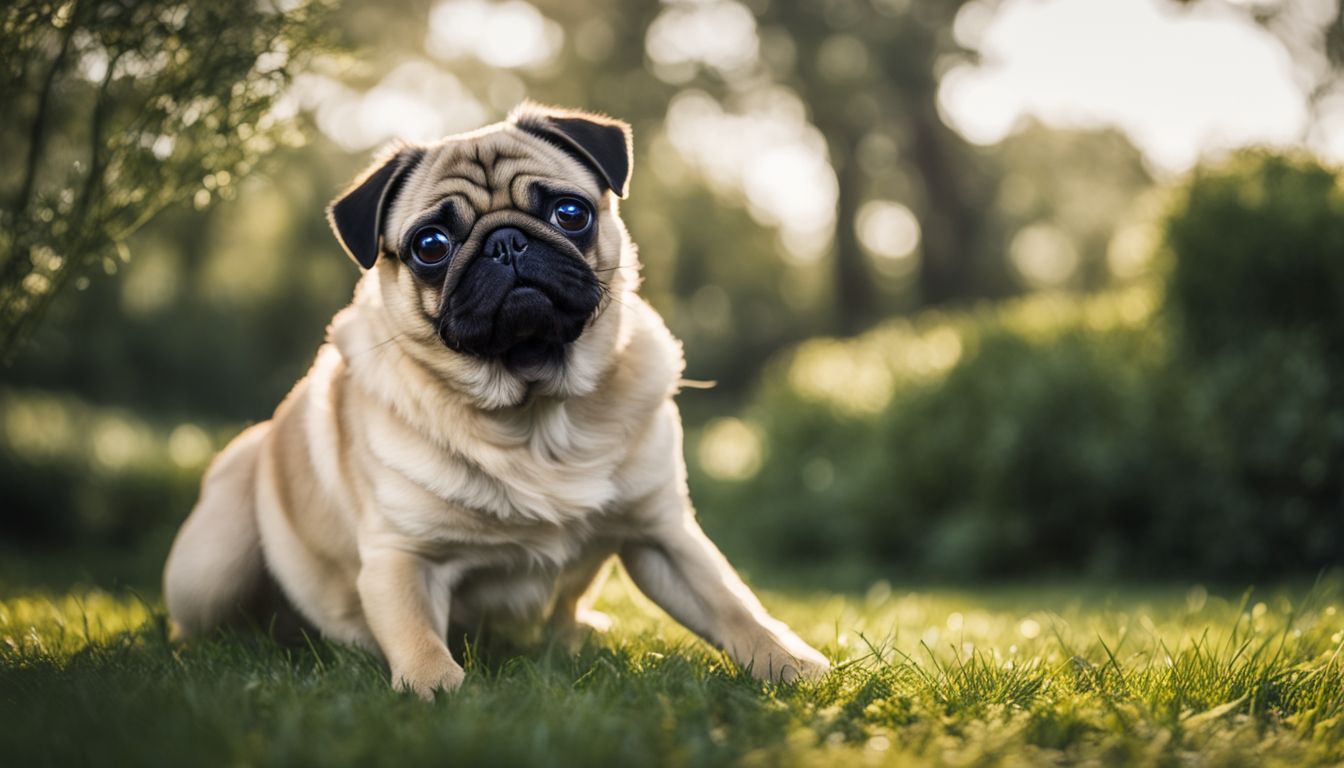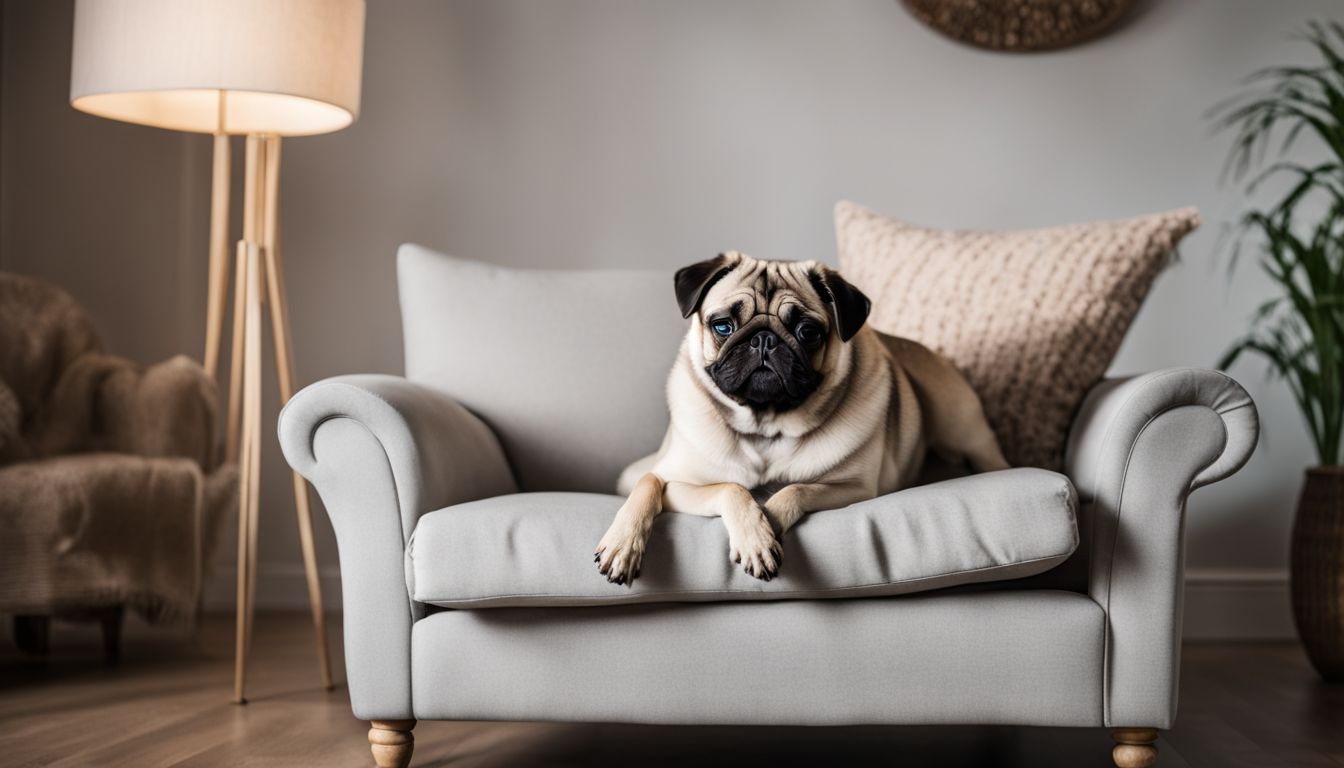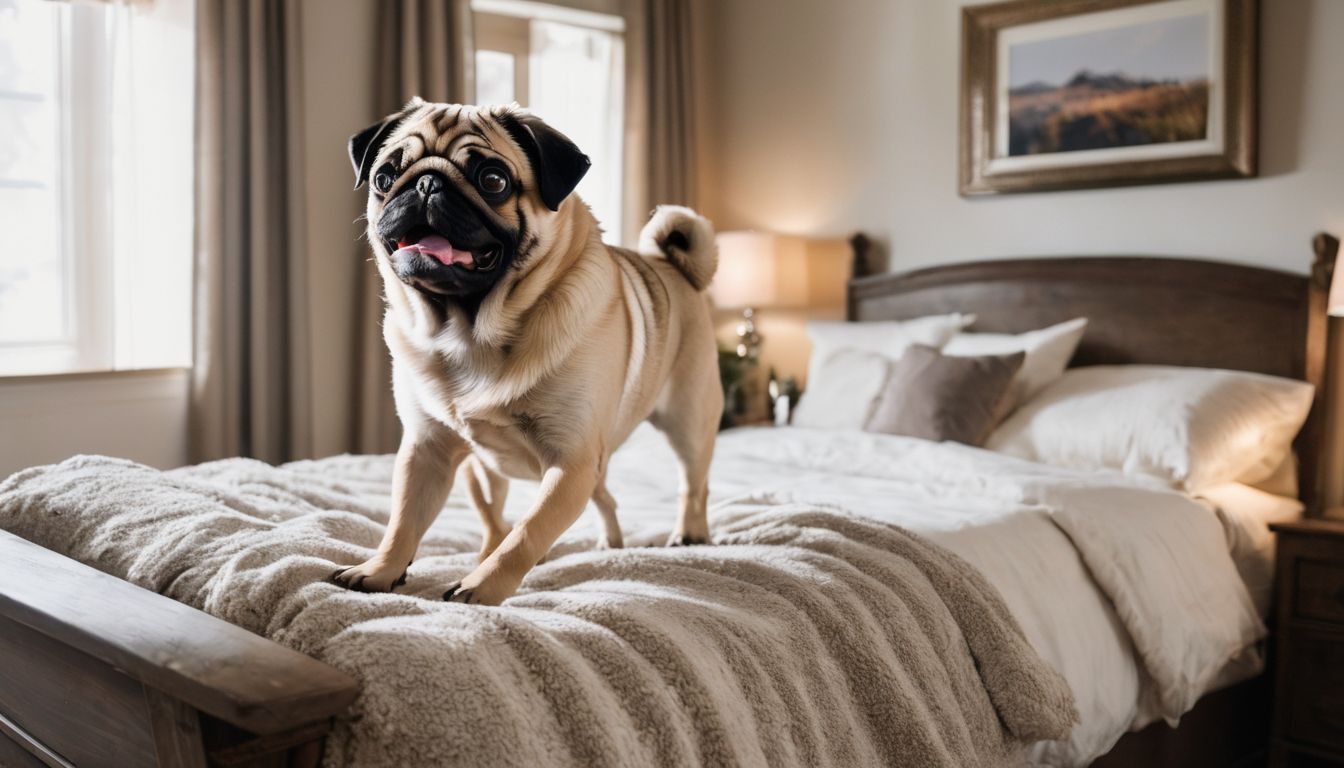Can Pugs Jump On The Bed? Exploring The Abilities Of Pugs To Jump On Furniture
Can Pugs Jump On The Bed?
Ever caught sight of your darling pug giving the bed those puppy eyes, as if pondering whether to leap up and join you? It’s a moment many pet parents know all too well. We’ve rolled up our sleeves and plunged into research to shed light on what kind of vaulting feats these lovable little pups are capable of.
In this upcoming article, we’ll walk you through everything from the surprising agility of pugs to possible risks and how to lend them a helping paw – all with safety in mind. So stay tuned for tips on making your home a pug-friendly playground while keeping good jumping manners in check!
Key Takeaways
- Pugs can jump onto low furniture, but their short legs and stocky build make higher jumps difficult and potentially dangerous.
- Factors like age, health conditions, weight, muscle strength, training, surface traction, and confidence play a role in a pug’s jumping abilities.
- Excessive jumping can cause joint injuries or aggravate existing conditions such as arthritis or hip dysplasia in pugs.
- Using dog ramps or steps is recommended to safely help pugs get on and off furniture without the risks associated with jumping.
- Regular exercise tailored to individual needs is necessary for pugs, taking into account that some may be more energetic than others.
Understanding Pugs and Their Natural Abilities

In our exploration of whether pugs can jump onto beds and furniture, it’s crucial to first grasp the unique physical composition and inherent capabilities of these charming canines.
Despite their enthusiastic spirits, pugs come with certain anatomical features that might limit their acrobatic aspirations, giving us insight into what they’re naturally designed to do – or not do.
Pugs’ physical limitations and tendencies
Pugs charm us with their playful antics and adorable faces, but these little pals have some physical limits we can’t ignore. Their compact, stocky bodies add to their cuteness but aren’t the best design for high-flying action.
With short legs and a solid build, pugging around on higher furniture isn’t always easy. They might manage a hop onto a comfy couch or padded chair, but leaping up to lofty beds can be too much of a stretch.
Their unique body structure also means they carry weight differently, which influences their agility and ability to jump effectively. Pug puppies may zip and zoom without much thought, yet as they mature into those irresistible wrinkles and rolls they slow down—some even showing signs of stifle joint extension just sitting around chillin’.
Each pug comes with its own set of capabilities though; what’s tough for one may be no biggie for another! Moving forward, let’s consider the factors that tweak our buddies’ acrobatic potential and find out exactly how high they can aim when it comes to jumping on furniture.
Factors that may affect a pug’s ability to jump
Our pugs possess unique characteristics that contribute to their ability to jump. Their short legs and robust bodies sometimes make it challenging for them to leap onto furniture like we might want them to. Here are some factors that play a part in how well our furry friends can hop onto the bed or couch:
- Physical Limitations: The pug’s stocky build, with its short legs and compact body, affects the height they can achieve when they jump. Smaller dogs can struggle with higher jumps.
- Muscular Strength: Like humans, a dog’s muscle power contributes significantly to its jumping prowess. Pugs need strong muscles to push off the ground effectively.
- Leg Length: Shorter legs mean shorter range of movement which can limit jumping height. Our pugs have relatively short legs compared to other breeds.
- Age Factor: Younger pugs often have more energy and less weight, making it easier for them to bounce around than adult or older pugs who may carry extra weight or suffer from age-related stiffness.
- Health Issues: Conditions like arthritis or intervertebral disc disease (IVDD), which are not uncommon in pugs, can hinder their ability to jump by causing pain or discomfort.
- Energy Levels: Not all pugs are bursting with energy; if they’re on the lazier side, they might prefer cuddling to jumping over high obstacles.
- Genetics: Each dog is different, and genetics play a role in determining how high a particular pug might be able to jump.
- Training and Encouragement: Dogs respond well to training and positive reinforcement. Some pugs might require extra coaching and rewards to learn and feel motivated enough to jump.
Can Pugs Jump on Furniture?

When we think of our little companions leaping onto the couch for snuggle time, one question that often comes to mind is: Can pugs jump on furniture? While these endearing pooches are known for their playful nature and affectionate personalities, their compact bodies and distinctive physical structure present a unique challenge when it comes to vertical endeavors.
Let’s delve into the capabilities of pugs and see how adept they truly are at conquering the heights of home furnishings.
How high can pugs jump?
Our pugs may not be high jump champions, but they can certainly surprise us with their leaping abilities. Despite their small size and stocky build, many pugs manage to hop onto lower pieces of furniture like couches and beds.
They do this using a burst of energy combined with the strength in their little legs. However, for higher jumps, our four-legged friends often face challenges due to the nature of their physique—short legs and a compact body means that gravity isn’t always on their side.
Knowing your pug’s limits is essential—while some might have the determination to vault up onto your bed for snuggle time, others prefer keeping all four paws comfortably on the ground.
Puppies especially may show more enthusiasm for jumping because they’re lighter and more flexible. We should keep an eye on them to ensure they’re safe while exploring their boundaries.
Next up: understanding what factors can influence these adorable dogs’ ability to get airborne.
Factors that may influence a pug’s jumping ability
Transitioning from the heights pugs can achieve when they jump, it’s crucial to understand what factors can influence their ability to spring onto the furniture they so often love. While some pugs might surprise you with their agility, there are several elements that play a role in determining just how well they can jump.
- Physical Build: Pugs are compact and muscular with short legs which means they’re not naturally built for high jumps. Their unique body structure can limit the height they’re able to reach.
- Age: Younger pugs tend to be more energetic and have stronger muscles, giving them better jumping capabilities than older pugs who may struggle due to age-related wear and tear on their joints.
- Health Conditions: Joint issues such as arthritis or spine problems including a bulging disc can severely restrict a pug’s jumping ability. These conditions cause pain and discomfort that may deter them from attempting to jump at all.
- Weight: A healthy weight is important for a pug’s overall health and agility. Overweight pugs will find it harder to jump because of the extra pounds they’re carrying, which puts additional stress on their bodies.
- Muscle Strength: Just like humans, the more a pug exercises, the stronger its muscles become. Regular playtime and activities help build muscle strength that supports better jumping skills.
- Training and Encouragement: Pugs who aren’t encouraged or trained to jump may be less likely to do so. Positive reinforcement can motivate them to try jumping onto furniture.
- Surface Traction: Slippery floors can make it difficult for pugs to get the grip they need to jump up successfully. Providing rugs or mats can help give them the traction necessary for takeoff.
- Confidence Levels: Some pugs might not trust their own abilities due to past experiences or lack of familiarity with jumping tasks. Building their confidence through gradual training can enhance their willingness to leap.
The Dangers of Too Much Jumping
While pugs may exhibit a playful nature that sees them bouncing toward their favorite perch, it’s crucial we recognize the risks excessive jumping poses to these compact canines. Exuberant leaps might lead not only to immediate mishaps but also pave the way for chronic health issues, which is why understanding and preventing such dangers are integral parts of caring for our pug companions.
Impact on joints and potential for injury
Pugs might look ready for action, but their adorable, squat bodies aren’t always up for serious jumping. These little dogs have a distinctive build that can make leaping onto your bed a tough task.
Their short legs and compact frame put extra stress on joints when they jump down from heights that are too steep for their small statures. This exertion can lead to injuries or worsen conditions like gait abnormalities, already prevalent in many pugs.
Every leap from the couch or bed is like an intense workout for a pug’s joints. Because of this strain on their intervertebral discs and stiffened joints – problems not uncommon in dutch bulldogs – these pooches risk getting hurt every time they hop up or down furniture.
It’s essential to consider safer ways to let our furry friends join us up high without asking too much of those tiny legs and vulnerable hips.
Different surfaces and their risks
Our furry friends face different challenges with each type of surface they encounter. Smooth, slippery floors like polished wood or tiles can be especially tricky for pugs, as their short legs may scramble for grip and cause them to slip.
This increases the risk of injuries such as sprains or strains. On the other hand, soft surfaces like thick carpets or rugs could catch their nails or make it harder to push off when trying to jump, which might lead to accidents if they’re not careful.
We must also watch out for beds and couches that are too high. Even though most pugs can manage a leap onto lower furniture without trouble, jumping on a taller bed requires more effort and poses a greater threat to their well-being.
A bad landing could result in joint problems or even paralysis – something we definitely want to avoid for our little companions. Always ensure there’s enough traction and consider the height before encouraging your pug to jump up beside you for some snuggle time.
Aggravating existing joint or back conditions
Jumping on and off furniture might seem like a simple act for many dogs, but for pugs with pre-existing joint or back problems, it can lead to further discomfort and pain. Their compact bodies and short legs aren’t just adorable—they’re also prone to conditions like hip dysplasia or patellar luxation which could worsen every time they land from a high jump.
If your pug has shown signs of gait abnormalities or hesitates before leaping onto the couch, these could be indicators that jumping is taking a toll on their little joints.
We need to be constantly aware of the surfaces our pugs are hopping up onto as well. Hardwood floors and slippery tiles offer no cushioning for impact, increasing the risk of injury significantly over softer options like carpets or rugs.
Even if you notice your pug flexing their muscles ready for takeoff, consider assisting them instead—lifting them gently can save them from long-term health issues related to their adventurous spirit.
With regular vet check-ups and mindful observation at home, we can help maintain our beloved pug’s health while still enjoying cuddle time on the sofa together.
Pug Training Tips for Safe Jumping
Understanding that training your pug to jump safely is crucial in preventing injuries, we’ll share effective strategies for encouraging your furry friend to approach furniture with caution.
From positive reinforcement techniques to setting up the right environment, we’ve got practical advice that will help you teach your pug how to navigate jumping onto cozy spots without harm.
Encouraging good behavior
Reward your pug with treats and affection when they successfully jump onto lower furniture or use a designated ramp. Positive reinforcement goes a long way in promoting good jumping habits that won’t harm their little legs.
Consistency is key, so make sure to praise every little success.
Train your playful companion by using toys to guide them onto safe surfaces. Ensure that these toys are easily visible and within reach to motivate your pug during training sessions.
This strategy helps associate the act of jumping onto appropriate furniture with fun and enjoyment, reinforcing good behavior without risking injury or developing bad habits.
Addressing issues such as laziness or reluctance
Sometimes our pug pals show a bit of laziness or seem reluctant to jump onto their favorite spots on the furniture. We know that only two out of five pugs may naturally enjoy jumping and running, while others might prefer lounging around.
To tackle this, we can introduce play sessions that include gentle encouragement for them to use their leg muscles more enthusiastically. Making a game out of jumping onto low pieces of furniture will both entertain them and provide the exercise they need.
If your pug’s hesitation seems out of character, it may be wise to assess any underlying health concerns such as gait abnormalities. Since these can affect their ability to move comfortably, it’s important for us to observe if there are signs indicating discomfort during movement or reluctance in jumping up and down from heights.
Once any health issues are ruled out or managed with veterinary guidance, using positive reinforcement techniques encourages our little companions to engage in more physical activities without forcing them beyond their comfort zones.
Alternative Options for Getting On and Off Furniture
For our beloved pugs who might struggle with jumping, there are safer and more comfortable alternatives to help them access their favorite spots on the furniture. Dog ramps or pet steps are an excellent solution that can prevent strain and injury, while also catering to the comfort of these small but mighty companions.
Dog ramps as a safe and convenient alternative
Dog ramps offer a fantastic solution to help our pugs navigate furniture safely. With their small, stocky build and not all of them being eager jumpers, a ramp provides an easy climb onto the bed or couch without risking injury to their joints.
These handy aids are especially useful for adult pugs who may struggle with gait abnormalities or for those with existing back conditions.
Installing dog ramps around the house helps maintain our furry friends’ independence while protecting them from the strain of jumping. They come in various designs and can be found at stores like Amazon.com, making it convenient to match one with your home decor.
Plus, using ramps encourages healthy habits for pugs prone to laziness by giving them a simple way to join you on the furniture for some companionship, without needing to leap up or down.
Pug-Proofing Your Home
Ensuring the safety of your pug extends beyond training and supervision; it involves making our living spaces secure for their curious nature. By pug-proofing our homes, we create an environment where they can roam freely without the risk of injury from unnecessary jumping or other hazards.
Preventing potential jumping hazards
To prevent potential jumping hazards for our pug friends, we need to be proactive in creating a safe environment. Since some pugs may struggle with jumps due to their stocky build and gait abnormalities, it’s essential to minimize risks at home.
One way is to keep floors clutter-free so there’s less chance of tripping or landing on something harmful during an attempted leap onto furniture. Secure loose rugs that could slide out from under them and cause injury, and consider arranging furniture in a way that reduces the temptation for risky jumps.
Our responsibility extends beyond just organizing; we must also provide alternatives like dog ramps or steps that help pugs access their favorite spots without the strain of jumping.
These aids cater especially to those who show signs of abnormal wearing and gait abnormalities, making life comfortable for every unique little character in our care. Moving forward, let us explore how hyperactivity plays into the lives of these affectionate canine companions in “Are Pugs Hyper? Understanding Their Energy Levels and Needs.”.
Are Pugs Hyper? Understanding Their Energy Levels and Needs
Many people wonder if pugs have a lot of energy because they seem so playful and affectionate. In reality, pugs are not usually hyperactive dogs. Their bursts of energy come in short spurts followed by long periods of rest.
Pugs enjoy a good play session or walk but will often be content to snuggle on the couch for hours. We need to provide them with both physical exercise and mental stimulation to keep them healthy and happy without overdoing it.
Pug owners must understand that while some pugs may show signs of high spirits, especially as puppies, others prefer a more laid-back lifestyle. Our little friends do love companionship and engaging activities that challenge their minds, yet we should always watch out for any signs of exhaustion or overheating due to their unique body structure and shortened snouts.
It’s crucial for us to tailor our activities to match each individual pug’s personality and physical capabilities rather than expecting all pugs to act the same way when it comes to their energy levels and needs.
Can Pugs Jump On The Bed Conclusion
In wrapping up, understanding a pug’s jumping capacity helps us create a comfortable and safe environment for these charming companions. Training and safety measures can enable them to navigate furniture with ease.
Let’s make their well-being our priority by providing the support they need for happy, healthy lives alongside us.
Can Pugs Jump On The Bed FAQs
1. Can pugs jump onto beds and furniture like other dogs?
Pugs have shorter legs, so while they may try to jump on beds just like Yorkies or Chihuahuas, it’s a bit harder for them. It’s important for owners to help their pug if they show interest in getting up on the furniture.
2. Are there certain breeds of dogs that can’t jump as high as others?
Yes, some dog breeds with shorter legs and longer bodies, such as Dachshunds, Basset Hounds, and even Pugs, might struggle more with jumping compared to breeds like Pomeranians or Yorkshire Terriers.
3. Can jumping onto furniture cause any problems for my pug?
Jumping could possibly lead to injuries in your pug due to their build. Keep an eye on how easily your pug moves around and consider safety measures if needed.
4. How do I keep my pet safe when they’re trying to get on the bed or couch?
To ensure your pet is safe when attempting to jump onto higher surfaces like beds or couches, provide steps or ramps especially designed for pets such as CKCS (Cavalier King Charles Spaniels), Dachshunds, Basset Hounds – these allow safer access without risking injury through jumping.







